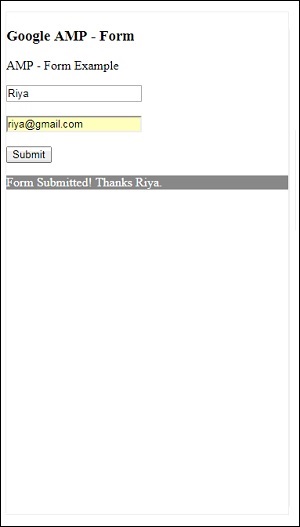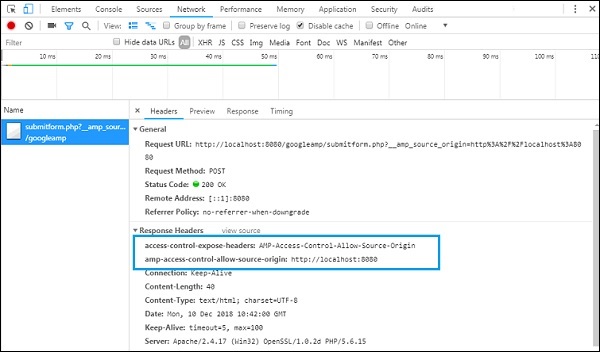
- Google AMP - Home
- Google AMP - Overview
- Google AMP - Introduction
- Google AMP - Images
- Google AMP - Form
- Google AMP - Iframes
- Google AMP - Video
- Google AMP - Button
- Google AMP - Timeago
- Google AMP - Mathml
- Google AMP - Fit Text
- Google AMP - Date Countdown
- Google AMP - Date Picker
- Google AMP - Story
- Google AMP - Selector
- Google AMP - Link
- Google AMP - Font
- Google AMP - List
- Google AMP - User Notification
- Google AMP - Next Page
- Google AMP - Attributes
- Styles And Custom CSS
- Google AMP - Dynamic CSS Classes
- Google AMP - Actions And Events
- Google AMP - Animations
- Google AMP - Data Binding
- Google AMP - Layout
- Google AMP - ADS
- Google AMP - Analytics
- Google AMP - Social Widgets
- Google AMP - Media
- Html Page To Amp Page
- Google AMP - Basic Syntax
- Google AMP - Validation
- Google AMP - Caching
- Google AMP - Custom Javascript
- Google AMP - Cors
- Google AMP Useful Resources
- Google AMP - Quick Guide
- Google AMP - Useful Resources
- Google AMP - Discussion
Google AMP - Cors
In this chapter, we will try to understand CORS in AMP. Before we dig deeper into the details, let us understand the basics of CORS and how it is useful.
What is CORS?
CORS stands for Cross Origin Resource Sharing. CORS is a process that needs extra HTTP header data to tell the browser whether the request made to the url by the web page running at say xyz.com origin should be given permission to access the data from the requested url. We make many http requests from the web page and for that we need to have CORS in place to get the data required.
When we make a http request to a different server than the host, we call it as cross origin request which means that either the domain, protocol, and port are different from the host origin. In such case, there should be a permission from the requested url for accessing the data; it means GET/PUT/POST/DELETE request made.
This additional data is available in the browser header for the http request call made. This step of permission is basically required for security reasons so that no webpage can make or get data from another domain without the required permission.
The header of the browser should have details such as Access-Control-Allow-Origin which can have values as shown below −
Access-Control-Allow-Origin : *
Having value * to the request URL header means it tells the browsers to allow requesting data from any origin to access the resource.
Access-Control-Allow-Origin: https://www.example.com
Having value as above tells the browser the request made from web page www.example.com will only be allowed to get the data for the requested url.
The server configuration for CORS has to be done keeping in mind how the data that is shared will be used. Depending on that the required headers has to be set on the server side.
Now that we know what CORS is, let us go another step ahead. In case of amp, we have components like amp-form, amp-list which uses http endpoints to load data dynamically.
In case of amp pages, even if the http request is made from the same origin we need to have CORS setting in place. Questions arise here why should we have CORS enabled even if the request and response will come from same origin. Technically we do not need CORS enabled in such case because we are requesting and displaying data for the same domain, origin etc.
Amp has a feature called caching which is added to get the data faster to the user who hits the page. In case the user has already visited the page, the data will be cached on google cdn the next user will get data served from the cache.
The data is stored at amp end which now has a different domain. When the user clicks any button to get fresh data, the amp cache url is compared with the webpage domain to get the new data. Here now if the CORS is not enabled as it deals with amp cached url and the webpage domain the request will not be valid and will fail for CORS permission. This is the reason why we need to have CORS enabled even for same origin in case of amp pages.
A working example of working with forms having CORS enabled is shown here −
<!doctype html>
<html amp lang = "en">
<head>
<meta charset = "utf-8">
<script async src = "https://cdn.ampproject.org/v0.js">
</script>
<title>Google AMP - Form</title>
<link rel = "canonical" href = "ampform.html">
<meta name = "viewport" content = "width = device-width,
minimum-scale = 1,initial-scale = 1">
<style amp-boilerplate>
body{
-webkit-animation:
-amp-start 8s steps(1,end) 0s 1 normal both;-moz-animation:
-amp-start 8s steps(1,end) 0s 1 normal both;-ms-animation:
-amp-start 8s steps(1,end) 0s 1 normal both;animation:
-amp-start 8s steps(1,end) 0s 1 normal both
}
@-webkit-keyframes
-amp-start{from{visibility:hidden}to{visibility:visible}}@-moz-keyframes
-amp-start{from{visibility:hidden}to{visibility:visible}}@-ms-keyframes
-amp-start{from{visibility:hidden}to{visibility:visible}}@-o-keyframes
-amp-start{from{visibility:hidden}to{visibility:visible}}@keyframes
-amp-start{from{visibility:hidden}to{visibility:visible}}
</style>
<noscript>
<style amp-boilerplate>
body{
-webkit-animation:none;
-moz-animation:none;
-ms-animation:none;
animation:none}
</style>
</noscript>
<script async custom-element = "amp-form"
src = "https://cdn.ampproject.org/v0/amp-form-0.1.js">
</script>
<script async custom-template = "amp-mustache"
src = "https://cdn.ampproject.org/v0/amp-mustache-0.2.js">
</script>
<style amp-custom>
form.amp-form-submit-success [submit-success],
form.amp-form-submit-error [submit-error]{
margin-top: 16px;
}
form.amp-form-submit-success [submit-success] {
color: white;
background-color:gray;
}
form.amp-form-submit-error [submit-error] {
color: red;
}
form.amp-form-submit-success.hide-inputs > input {
display: none;
}
</style>
</head>
<body>
<h3>Google AMP - Form</h3>
<form
method = "post"
class = "p2"
action-xhr = "submitform.php"
target = "_top">
<p>AMP - Form Example</p>
<div>
<input
type = "text"
name = "name"
placeholder = "Enter Name" required>
<br/>
<br/>
<input
type = "email"
name = "email"
placeholder = "Enter Email"
required>
<br/>
<br/>
</div>
<input type = "submit" value = "Submit">
<div submit-success>
<template type = "amp-mustache">
Form Submitted! Thanks {{name}}.
</template>
</div>
<div submit-error>
<template type = "amp-mustache">
Error! {{name}}, please try again.
</template>
</div>
</form>
</body>
</html>
submitform.php
<?php
if(!empty($_POST)){
$domain_url = (isset($_SERVER['HTTPS']) ? "https" : "http") .
"://$_SERVER[HTTP_HOST]";
header("Content-type: application/json");
header("AMP-Access-Control-Allow-Source-Origin: " . $domain_url);
header("Access-Control-Expose-Headers:
AMP-Access-Control-Allow-Source-Origin");
$myJSON = json_encode($_POST);
echo $myJSON;
}
?>
Output

The details of response headers added to submitform.php −

For the form to work, we need to add headers like access-control-expose-headers with value AMP-Access-Control-Allow-Source-Origin and amp-access-control-allow-source-origin − http://localhost:8080.
Here we are using php file and apache is the server used. In php file, we have added the required headers as shown below −
<?php
if(!empty($_POST)){
$domain_url = (isset($_SERVER['HTTPS']) ? "https" : "http") .
"://$_SERVER[HTTP_HOST]";
header("Content-type: application/json");
header("AMP-Access-Control-Allow-Source-Origin: " . $domain_url);
header("Access-Control-Expose-Headers:
AMP-Access-Control-Allow-Source-Origin");
$myJSON = json_encode($_POST);
echo $myJSON;
}
?>
When the required headers are added, the origin http://localhost:8080 will be allowed to interact and get the data back.,